
A subwoofer is a loudspeaker designed to reproduce low-pitched audio frequencies, known as bass and sub-bass, that are lower in frequency than those which can be (optimally) generated by a woofer. The typical frequency range that is covered by a subwoofer is about 20–200 Hz for consumer products, below 100 Hz for professional live sound, and below 80 Hz in THX-certified systems. Thus, one or more subwoofers are important for high-quality sound reproduction as they are responsible for the lowest two to three octaves of the ten octaves that are audible. This very low-frequency (VLF) range reproduces the natural fundamental tones of the bass drum, electric bass, double bass, grand piano, contrabassoon, tuba, in addition to thunder, gunshots, explosions, etc.

A loudspeaker is an electroacoustic transducer that converts an electrical audio signal into a corresponding sound. A speaker system, also often simply referred to as a speaker or loudspeaker, comprises one or more such speaker drivers, an enclosure, and electrical connections possibly including a crossover network. The speaker driver can be viewed as a linear motor attached to a diaphragm which couples that motor's movement to motion of air, that is, sound. An audio signal, typically from a microphone, recording, or radio broadcast, is amplified electronically to a power level capable of driving that motor in order to reproduce the sound corresponding to the original unamplified electronic signal. This is thus the opposite function to the microphone; indeed the dynamic speaker driver, by far the most common type, is a linear motor in the same basic configuration as the dynamic microphone which uses such a motor in reverse, as a generator.

A microphone, colloquially called a mic, or mike, is a transducer that converts sound into an electrical signal. Microphones are used in many applications such as telephones, hearing aids, public address systems for concert halls and public events, motion picture production, live and recorded audio engineering, sound recording, two-way radios, megaphones, and radio and television broadcasting. They are also used in computers and other electronic devices, such as mobile phones, for recording sounds, speech recognition, VoIP, and other purposes, such as ultrasonic sensors or knock sensors.
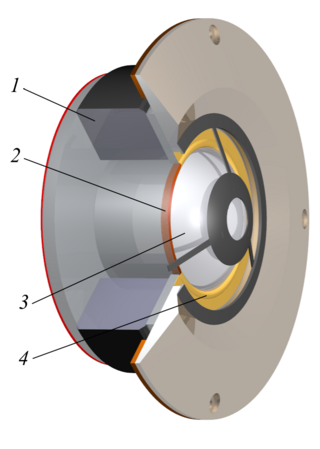
A tweeter or treble speaker is a special type of loudspeaker that is designed to produce high audio frequencies, typically deliver high frequencies up to 100 kHz. The name is derived from the high pitched sounds made by some birds (tweets), especially in contrast to the low woofs made by many dogs, after which low-frequency drivers are named (woofers).
A woofer or bass speaker is a technical term for a loudspeaker driver designed to produce low frequency sounds, typically from 20 Hz up to a few hundred Hz. A subwoofer can take the lower part of this range, normally up to 80 Hz. The name is from the onomatopoeic English word for a dog's deep bark, "woof". The most common design for a woofer is the electrodynamic driver, which typically uses a stiff paper cone, driven by a voice coil surrounded by a magnetic field.

Headphones are a pair of small loudspeaker drivers worn on or around the head over a user's ears. They are electroacoustic transducers, which convert an electrical signal to a corresponding sound. Headphones let a single user listen to an audio source privately, in contrast to a loudspeaker, which emits sound into the open air for anyone nearby to hear. Headphones are also known as earphones or, colloquially, cans. Circumaural and supra-aural headphones use a band over the top of the head to hold the speakers in place. Another type, known as earbuds or earpieces, consists of individual units that plug into the user's ear canal. A third type are bone conduction headphones, which typically wrap around the back of the head and rest in front of the ear canal, leaving the ear canal open. In the context of telecommunication, a headset is a combination of a headphone and microphone.

Infrasound, sometimes referred to as low frequency sound, describes sound waves with a frequency below the lower limit of human audibility. Hearing becomes gradually less sensitive as frequency decreases, so for humans to perceive infrasound, the sound pressure must be sufficiently high. While the ear is the primary organ for sensing low sound, at higher intensities it is possible to feel infrasound vibrations in various parts of the body.
A transducer is a device that converts energy from one form to another. Usually a transducer converts a signal in one form of energy to a signal in another. Transducers are often employed at the boundaries of automation, measurement, and control systems, where electrical signals are converted to and from other physical quantities. The process of converting one form of energy to another is known as transduction.
The low-frequency effects (LFE) channel is a band-limited audio track that is used for reproducing deep and intense low-frequency sounds in the 3–120 Hz frequency range.

An instrument amplifier is an electronic device that converts the often barely audible or purely electronic signal of a musical instrument into a larger electronic signal to feed to a loudspeaker. An instrument amplifier is used with musical instruments such as an electric guitar, an electric bass, electric organ, electric piano, synthesizers and drum machine to convert the signal from the pickup or other sound source into an electronic signal that has enough power, due to being routed through a power amplifier, capable of driving one or more loudspeaker that can be heard by the performers and audience.
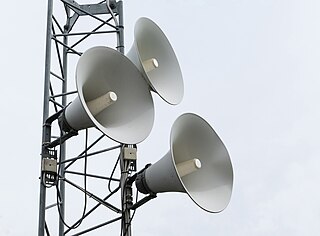
A public address system is an electronic system comprising microphones, amplifiers, loudspeakers, and related equipment. It increases the apparent volume (loudness) of a human voice, musical instrument, or other acoustic sound source or recorded sound or music. PA systems are used in any public venue that requires that an announcer, performer, etc. be sufficiently audible at a distance or over a large area. Typical applications include sports stadiums, public transportation vehicles and facilities, and live or recorded music venues and events. A PA system may include multiple microphones or other sound sources, a mixing console to combine and modify multiple sources, and multiple amplifiers and loudspeakers for louder volume or wider distribution.

A sound reinforcement system is the combination of microphones, signal processors, amplifiers, and loudspeakers in enclosures all controlled by a mixing console that makes live or pre-recorded sounds louder and may also distribute those sounds to a larger or more distant audience. In many situations, a sound reinforcement system is also used to enhance or alter the sound of the sources on the stage, typically by using electronic effects, such as reverb, as opposed to simply amplifying the sources unaltered.
In the field of acoustics, a diaphragm is a transducer intended to inter-convert mechanical vibrations to sounds, or vice versa. It is commonly constructed of a thin membrane or sheet of various materials, suspended at its edges. The varying air pressure of sound waves imparts mechanical vibrations to the diaphragm which can then be converted to some other type of signal; examples of this type of diaphragm are found in microphones and the human eardrum. Conversely a diaphragm vibrated by a source of energy beats against the air, creating sound waves. Examples of this type of diaphragm are loudspeaker cones and earphone diaphragms and are found in air horns.

A pickup is a transducer that captures or senses mechanical vibrations produced by musical instruments, particularly stringed instruments such as the electric guitar, and converts these to an electrical signal that is amplified using an instrument amplifier to produce musical sounds through a loudspeaker in a speaker enclosure. The signal from a pickup can also be recorded directly.
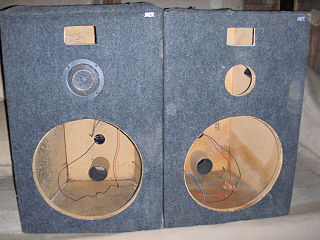
A loudspeaker enclosure or loudspeaker cabinet is an enclosure in which speaker drivers and associated electronic hardware, such as crossover circuits and, in some cases, power amplifiers, are mounted. Enclosures may range in design from simple, homemade DIY rectangular particleboard boxes to very complex, expensive computer-designed hi-fi cabinets that incorporate composite materials, internal baffles, horns, bass reflex ports and acoustic insulation. Loudspeaker enclosures range in size from small "bookshelf" speaker cabinets with 4-inch (10 cm) woofers and small tweeters designed for listening to music with a hi-fi system in a private home to huge, heavy subwoofer enclosures with multiple 18-inch (46 cm) or even 21-inch (53 cm) speakers in huge enclosures which are designed for use in stadium concert sound reinforcement systems for rock music concerts.
A rotary woofer is a subwoofer-style loudspeaker which reproduces very low frequency content by using a conventional speaker voice coil's motion to change the pitch (angle) of the blades of an impeller rotating at a constant speed. The pitch of the fan blades is controlled by the audio signal presented to the voice coil, and is able to swing both positive and negative, with respect to a zero pitch spinning blade position. Since the audio amplifier only changes the pitch of the blades, it takes much less power, per dB of generated acoustic sound level, to drive a rotary woofer than to power a conventional subwoofer, which uses a moving electromagnet placed within the field of a stationary permanent magnet to drive a cone which then displaces air. Rotary woofers excel at producing sounds below 20 Hz, below the normal hearing range; when installed in the wall of a sealed room, they can produce audio frequencies down to 0 Hz, a static pressure differential, by simply compressing the air in the sealed room.

The moving iron speaker was the earliest type of electric loudspeaker. They are still used today in some miniature speakers where small size and low cost are more important than sound quality. A moving iron speaker consists of a ferrous-metal diaphragm or reed, a permanent magnet and a coil of insulated wire. The coil is wound around the permanent magnet to form a solenoid. When an audio signal is applied to the coil, the strength of the magnetic field varies, and the springy diaphragm or reed moves in response to the varying force on it. The moving iron loudspeaker Bell telephone receiver was of this form. Large units had a paper cone attached to a ferrous metal reed.

An electrodynamic speaker driver, often called simply a speaker driver when the type is implicit, is an individual transducer that converts an electrical audio signal to sound waves. While the term is sometimes used interchangeably with the term speaker (loudspeaker), it is usually applied to specialized transducers which reproduce only a portion of the audible frequency range. For high fidelity reproduction of sound, multiple loudspeakers are often mounted in the same enclosure, each reproducing a different part of the audible frequency range. In this case the individual speakers are referred to as drivers and the entire unit is called a loudspeaker. Drivers made for reproducing high audio frequencies are called tweeters, those for middle frequencies are called mid-range drivers, and those for low frequencies are called woofers, while those for very low bass range are subwoofers. Less common types of drivers are supertweeters and rotary woofers.
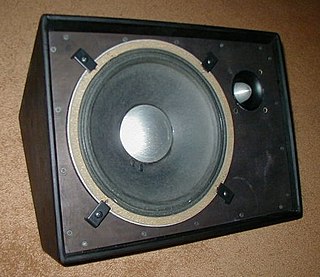
A stage monitor system is a set of performer-facing loudspeakers called monitor speakers, stage monitors, floor monitors, wedges, or foldbacks on stage during live music performances in which a sound reinforcement system is used to amplify a performance for the audience. The monitor system allows musicians to hear themselves and fellow band members clearly.
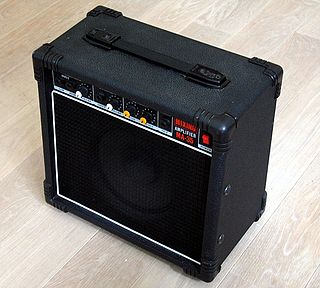
A keyboard amplifier is a powered electronic amplifier and loudspeaker in a wooden speaker cabinet used for the amplification of electronic keyboard instruments. Keyboard amplifiers are distinct from other types of amplification systems such as guitar amplifiers due to the particular challenges associated with making keyboards sound louder on stage; namely, to provide solid low-frequency sound reproduction for the deep basslines that keyboards can play and crisp high-frequency sound for the high-register notes. Another difference between keyboard amplifiers and guitar/bass amplifiers is that keyboard amps are usually designed with a relatively flat frequency response and low distortion. In contrast, many guitar and bass amp designers purposely make their amplifiers modify the frequency response, typically to "roll-off" very high frequencies, and most rock and blues guitar amps, and since the 1980s and 1990s, even many bass amps are designed to add distortion or overdrive to the instrument tone.














